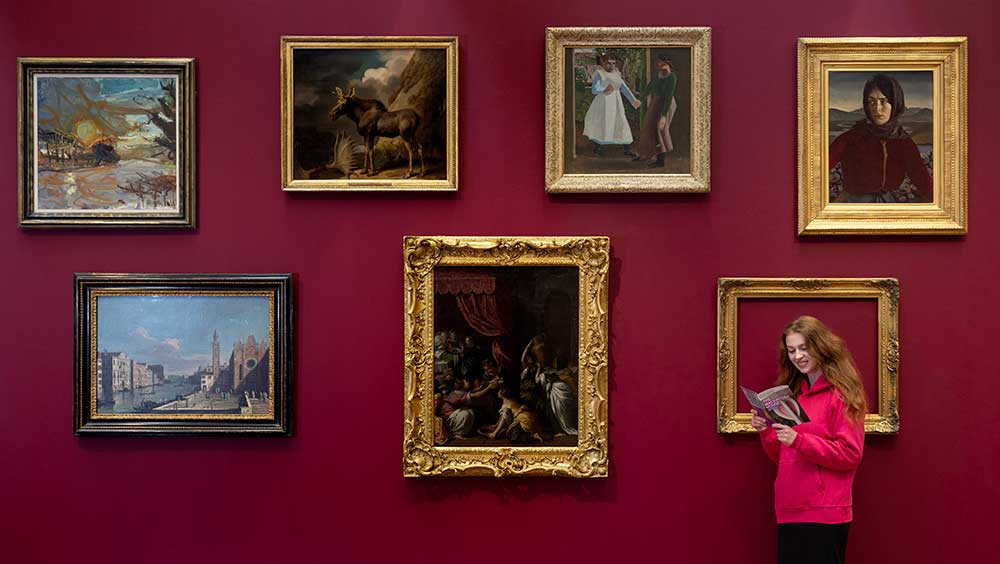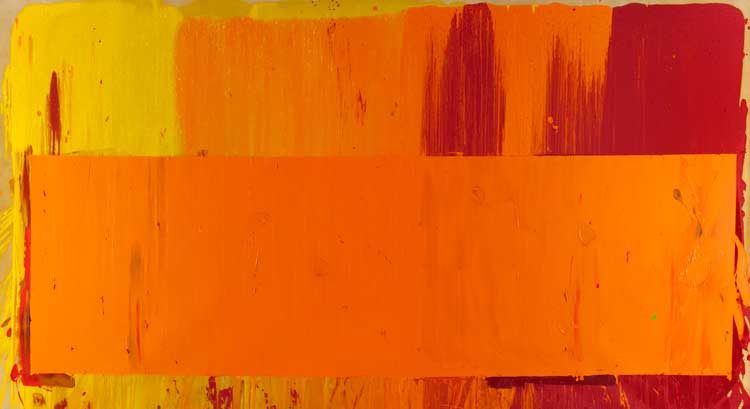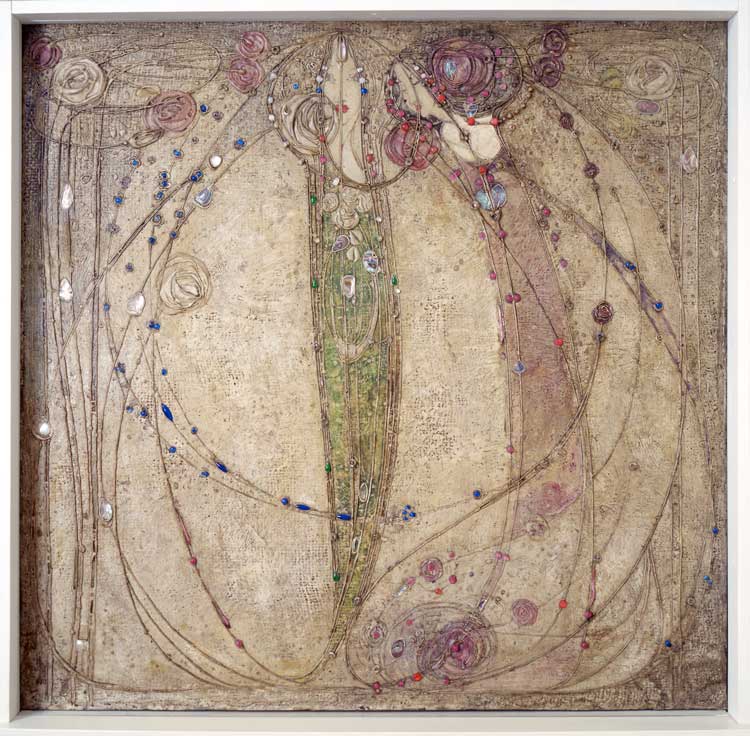
Hunterian Visitor Experience Assistant Esme Rankin in the reframed Hunterian Art Gallery. Photo courtesy Martin Shields Photography.
Hunterian Art Gallery, University of Glasgow
Ongoing
by BETH WILLIAMSON
Founded in 1807, the Hunterian at the University of Glasgow is Scotland’s oldest public museum. It was also the first to have its entire collection recognised as being of national significance for Scotland so it has a long history of access and excellence. In 2012, David Gaimster, then the Hunterian’s director, published a small book, The Hunterian, University of Glasgow (Director’s Choice), of objects from the collection, including the art collection. Looking back now, that selection was conservative, predictable, even, and contained only one work by a female artist – it was Joan Eardley’s Glasgow Close (1960), if you were wondering. Every other work from the art collection selected by Gaimster to feature in that publication was by a white male artist.
So how do you reframe a historic collection like this to reflect contemporary concerns? How do you question what it includes while revealing more of what has remained hidden, and all while continuing to advocate for its value and usefulness as a historic collection of contemporary relevance? These are precisely the difficult and complex questions that the Hunterian Art Gallery at the University of Glasgow has had to tackle in reframing its collection, newly revealed to visitors in April.

John Hoyland, 18-6-69, 1969-70. Acrylic on cotton duck. The Hunterian, University of Glasgow. © estate of John Hoyland. All rights reserved. DACS 2023.
Working with the collection, curators have identified new themes, ideas and approaches that invite questions, dialogue and discussion. The overall rehang, or reframe, as it is rightly being called, aims to highlight inequalities of the past while addressing contemporary life. There is a much greater role for the visitor, too, requiring independent thinking and meaning-making, albeit with a curatorial hand prompting and guiding along the way.
This new hang is not ashamed to recognise its past shortcomings; indeed, it uses them as shared points of learning regarding Glasgow’s relationship with empire, transatlantic slavery, colonialism and migration. Neither is it shy about its successes; displaying works that have benefited from conservation, such as John Hoyland’s 18-6-69 (1969-70) or Margaret Mackintosh’s gesso panel The White Rose and the Red Rose (1902), not displayed since 2016, or looking to the margins of art production in one way or another. There are all the names you might expect here: James McNeill Whistler, the Glasgow Boys and the Scottish Colourists, as well as Margaret MacDonald and Charles Rennie Mackintosh. There are also works by leading contemporary artists such as Christine Borland, Lucy Skaer and Adam Pendleton.

Margaret Macdonald Mackintosh, The White Rose and the Red Rose, 1902. Gesso, set with glass beads and shell, on hessian on a wooden stretcher. © The Hunterian, University of Glasgow.
Every space within the gallery is devoted to an overarching theme that requires something different from the viewer in each instance. The first space you enter has no labels at all. Paintings are hung around the walls in old-fashioned salon style, but without even a title, date or artist’s name. There is even an empty frame, seemingly ready for another painting to be added. It is bamboozling until you realise, thanks to the Bloomberg Connects guide, that it is intended as a history lesson, as well as representing the galley’s “openness to the many unique perspectives that have and will continue to shape and reshape art and its meanings”. I get it – really, I do – but the take-away from this first gallery space is one of confusion and, if I am honest, a slight sense of anxiety about whether there will be any information at all on the walls in what follows. I need not have worried.

Jean-Siméon Chardin, A Lady Taking Tea, 1735. Oil own canvas. © The Hunterian, University of Glasgow.
A series of thematic rooms pose questions, or set themes, through the presentation of paintings that hope to, in some way, help visitors come to some sort of resolution in their thinking: What Makes a Portrait?, History and Memory, The World in a Teacup, Re-forming Canons of Art, A Modern Gallery, Art Making, Colour and Light, Art and Science, Art Across Borders and In Relation: Reunions. The World in a Teacup is a good example of how existing works have been used to pose new questions. Here, regular visitors will still be able to see favourite works including A Lady Taking Tea (1735) by Jean-Baptiste Siméon Chardin. Now, however, that work, once voted Glasgow’s second favourite painting, becomes a point of departure to consider the effect of tea imports, sugar produced by enslaved peoples, the colonisation of China, India, the Caribbean islands and the Americas where local people and products were exploited.
Borland’s Family Conversation Piece (1998) addresses many of these issues by presenting a series of five skulls cast in bone china and decorated in the style of English delftware. This work was originally made to be exhibited in Liverpool with its history as a bone china producer and as a trading port to Africa and the Far East dealing in produce and slaves. A Lady Taking Tea does not look so genteel now.

Samuel John Peploe, A Paris Street, 1906-08. Oil on panel. © The Hunterian, University of Glasgow.
In Art Across Borders, we see other countries through the eyes of Scottish painters and vice versa. There is SJ Peploe’s A Paris Street (1906-08), but there is also Piero San Salvadore’s Trongate at Glasgow Cross (1932). In Reforming Canons of Art, we see oil painting of the 1500s alongside graphic arts from the 1800s, as well as medals, caskets and jewels from around the globe. Claiming space for a larger range of objects in this way raises questions about how and why we value particular objects and not others. Other themed spaces function in a similar way, highlighting and questioning what we thought we knew.
The gallery I haven’t yet mentioned is the final gallery space, In Relation: Unexpected Encounters. Sadly, this is rather disappointing. It felt as if, after all the hard work and good intentions, the gallery had run out of ideas and, with some exceptions, put odd works together in “unexpected encounters”. Like the very first gallery, this last one didn’t work for me and where first and last experience serve to shape our engagement with a collection, it doesn’t serve well here. It is a real shame because I don’t want to end on a sour note and, despite a weak start and a disappointing finish, the vast majority of the reframed themes and questions serve the collection very well and make for a challenging and enjoyable experience.
A large part of what has been achieved here is informative, stimulating and commendable. Be prepared to face some difficult questions surrounding the city’s deep histories in empire, transatlantic slavery, colonialism and migration, the difficult questions that all organisations and institutions are rightly asking at the present time. Still, the curators have not forgotten that art is there to be enjoyed too. Savour these new perspectives on this historic collection. There really is a lot to take in, so it is probably a collection display you will want to return to again and again.